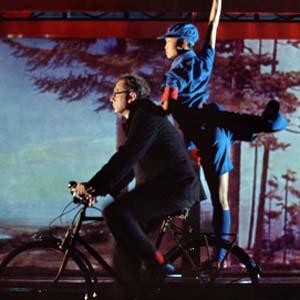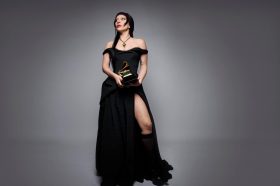Robert Lepage’s The Blue Dragon tells a simple story in a technically extravagant way, mesmerizingly beautiful it’s breath-taking in its transmission of cinematic techniques to the stage. Every staging element is rendered down to its simplest symbol to tell the largest story.
There seems something wistful in this production, that perhaps comes from the revisiting of Pierre Lamontagne, the central character who ‘left to study art in China’ at the end of The Dragon’s Trilogy the 1985 production, which first brought Lepage international recognition. Since, of course Lepage’s career has gone from strength to strength, considered a veritable virtuoso of multidisciplinary stagecraft, as a director, scenic artist, playwright, actor and producer with awards and accolades for his film, operatic and theatrical productions. French-Canadian Lepage’s penchant for the epic is well known to Australian audiences, with his works regularly appearing at Australian festivals since the early 90s, such as Bluebeard’s Castle with the Canadian Opera Company (Melbourne 1994) The Seven Streams of the River Ota (Adelaide 1998), The Busker’s Opera (Melbourne Festival 2004), the re-versioned Dragon’s Trilogy (Perth 2006), and Lipsynch (Sydney Festival 2009).
In the The Blue Dragon, which Lepage co-wrote with actor Marie Michaud, Lepage is imagining the character of Lamontagne 25 years on, placing him in the heart of Shanghai’s artistic district and on the magmatic hotspot of Chinese modernisation. In the Director’s Notes, Lepage say, ‘China is on the cusp of change, poised at a crossroads of vast ideas and limitless possibilities’. It is this energy that Lamontagne continues to seek, and as a setting it provides Lapage with all the canvas he could want for creating a visual extravaganza.
French-Canadian artist Pierre Lamontagne (Henri Chasse) is in Shanghai to ‘live on the cutting edge of history’ but in his late 40s he is no longer on the cutting edge himself. He is no longer making his own art; instead he lives in a warehouse conversion in the Moganshan 50 district and runs an art gallery exhibiting up-coming local artists. One of whom, he discovered in a tattoo parlour in Hong Kong, and has become his lover. The exuberant, young and bold artist, Xiao Ling (Tai Wei Foo), ambitious and talented she is a woman going places, perhaps only temporarily with him.
When former lover Claire Foret (Marie Michaud), now a brittle, heavy drinking advertising executive comes to China to desperate to adopt a child, Pierre’s old and new lives are exposed, with unresolved feelings and nostalgia clashing with a restless pride and his desire to live beyond the prosaic. However, the dramatic tension is built in the relationship between the two women, as they unwittingly discover each other’s roles in Pierre’s life and the irony of how each could assist the other achieve their objectives, though whether they will or can is ambiguous. The central dramatic question is unanswered, which in itself seems a deliberate obfuscation, and metaphor for the crossroads of character and place.
There are strong performances from all three actors. Michaud plays the laconic humour and raw vulnerability of Clare with sensitivity and poignancy while Tai Wei Foo captures the volatility and candour of Xiao Ling. Pierre’s stolidness and role as narrator limits the range possible for Chasse yet he also is convincing as a man torn but resilient.
The real star of the show however is the staging. Sliced into two staging tiers with four panels on each, that could be independently raised and lowered, projected upon or lit the set provided a dizzying array of vertical and panelled space and image combinations. Arrival and Departure boards projected above took us to Pudong airport, transformed into shadowy feet with the area below in darkness we were in an underground railway, yet with the screens removed Pierre’s warehouse apartment was revealed, with high opaque windows through which lightening flashed. Each scene was sketched out with crafted minimalism; the two tiers frequently used to provide split screen style effects. Scenes changed like film cuts, actors reappearing from one side to the other apparently instantly and all were combined with lavish lighting effects and emotive use of music and sound.
The sophistication of the technical displays was juxtaposed with the almost laughable diorama naivety of model trains and boats chugging in the foreground to symbolise a train journey at night or the river traffic by The Bund. Propped bicycles slid on moving tracks across the stage as the actors dreamily rode through symbolic journeys. Saying it is a multi-media production seems too banal, it can’t come close to explaining how the integration of audio-visual, music, dance, lighting and performance make a compositional whole.
Perhaps most stunning were the interstitial dance sequences choreographed and performed by Tai Wei Foo. The movements of her traditional long-sleeved dress exaggerated by rippling light and colour projected in gigantic swathes behind her, as though she could dance in light and snow-blossom. These sequences told the broader story of how China is grappling with a rapidly changing culturally identity juxtaposing traditional Chinese dance, Mao-ist propaganda art and ballet with audio visual elements such as a Chinese KFC advertisement.
Having been to Shanghai recently myself, the transformation of the set into shuttered shop fronts, the bicycles, the skyline of Shanghai and the contrasts of old and new life were so powerful I could almost smell it, relishing that memory of the extraordinary energy and unrelenting drive of the city.
If there were quibbles to be had they came from the excessive sped of some scene changes, that did not always use their potential editing capacity to full effect. Some scenes needed time to sigh before we breathed into the next but instead we raced from place to place. Also, at times the translation between French, Mandarin and English was distracting, and seemingly not keeping pace with the actors.
For all of The Blue Dragon sensational visuals the characters themselves seem emotional distant to the viewer, observed rather than engaged with, their story was somehow smaller than the setting they occupied. In the end the audience is left reflecting on what was as much an intellectual conundrum as an visual spectacular.
At the Friday night opening, and reportedly at each of the subsequent performance over the weekend, the twelve technical crew shared the stage to taking a bow, reminding us as if it were necessary that this was not just a drama staged by actors but a performance of technology as well.
MELBOURNE INTERNATIONAL FESTIVAL
8 – 23 October 2010
The Blue Dragon
Robert Lepage
Fri 8 – Sat 9 Oct &
Mon 11 – Tue 12 Oct at 8pm
Sat 9 Oct at 2pm
Sun 10 Oct at 6pm
1hr 45min no interval
the Arts Centre, Playhouse
100 St Kilda Road
MELBOURNE 3004
A Reserve Adult $75.00
A Reserve Group (8+) $67.50
A Reserve Concession $56.25
A Reserve Student $25.00
B Reserve Adult $60.00
B Reserve Concession $45.00
B Reserve Student $25.00
Written by Robert Lepage, Marie Michaud
English Translation Michael Mackenzie
Director Robert Lepage
Performers Henri Chassé, Marie Michaud, Tai Wei Foo
Set Designer Michel Gauthier
Properties Designer Jeanne Lapierre
Sound Designer Jean-Sébastien Côté
Lighting Designer Louis-Xavier Gagnon-Lebrun
Costume Designer François St-Aubin
Projection Designer David Leclerc
Choreographer Tai Wei Foo
Technical Director Pierre Gagné




